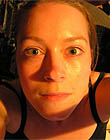|
|
This topic comprises 2 pages: 1 2
|
|
Author
|
Topic: Satellite receivers for live events -what do you use?
|
Elise Brandt
Expert Film Handler

Posts: 160
From: Kuusankoski, FIN/ Kouvola, Finland
Registered: Dec 2009
|
 posted 06-18-2011 04:23 AM
posted 06-18-2011 04:23 AM




Long time no write. Been reading though...
First, I'm not sure if this should go to ground level but since it's equipment based it might fall into the digital side. The problem: we have started to receive live events via satellite in addition to recorded content in our cinema. The first live event did not go well (ended up looking unwatchable so we had to go to plan b and show a recorded event as a backup. Audience was happy, I think mostly because we talked to them through the problem, let them know instantly what was going on and kep them informed) and the other end of the transmission says levels were good, dish size is fine, everything looks good... the only weak link is the receiver box at our end.
We are in the process of trying to find a new receiver now, but cannot find information as to which to choose. Salespeople we cannot trust here, I want a professional opinion. Those of you who use satellite receivers, what do you use? Which ones work and have you thrown any out the window? Ours was a Vantage, and I won't even go into detail unless someone asks...
Please help us out. Our next live event is in September and we have the summer to make any upgrades. All we lack is the experience of someone who has been using this equipment for some time and can educate us a bit.
Thank you for reading.
| IP: Logged
|
|
|
|
Elise Brandt
Expert Film Handler

Posts: 160
From: Kuusankoski, FIN/ Kouvola, Finland
Registered: Dec 2009
|
 posted 06-18-2011 05:39 AM
posted 06-18-2011 05:39 AM




Thanks for the suggestions.
Indeed measuring the test transmissions is tricky because they only do very few of those and about 10 days before the event an hour at a time, that gives very little time to try out different options, boxes and cables. Therein lies the problem. Since we can't test the new equipment but limitedly, I want to get the absolute top receiver, not a domestic model. Signal strength and dish size are good, says the helpdesk where the transmission comes from, and I'm inclined to believe them... it's the receiver salespeople I don't trust. Of course everyone says their equipment is the best, why wouldn't they? That's why I'm grateful for any info on what others use and if they've managed to get decent results with them.
I did look at that box you linked to, before I posted, looked good to me then. I'll take it as a good sign.
Tahnk you for the input and the links. I truly appreciate it!
| IP: Logged
|
|
|
|
Elise Brandt
Expert Film Handler

Posts: 160
From: Kuusankoski, FIN/ Kouvola, Finland
Registered: Dec 2009
|
 posted 06-18-2011 05:51 AM
posted 06-18-2011 05:51 AM




The current box gave us a goodish signal twice during the test transmission. We had another box (same make, different model that we got in the first place, the current was left to us as a back-up) that we switched to during that test, hoping to get a better signal and that box gave absolutely nothing off the same frequency. Switched back, and got signal again. TV-channels the lttle darling picks up like crazy but nobody's interested in those... at least we know it works, if badly.
Strength and quality were both in the 70-80% range with the box that got any in the first place. Since testing from the dish directly (according to our installator) looked very good, we can only assume it is the box that gives the variance.
We got our material from Intelsat 10-02 with a 110cm dish, which according to te transmitter side, is big enoug. Nobody would give me numbers on the strength of the transmission though.
| IP: Logged
|
|
Carsten Kurz
Film God
Posts: 4340
From: Cologne, NRW, Germany
Registered: Aug 2009
|
 posted 06-19-2011 08:08 AM
posted 06-19-2011 08:08 AM




These given percentages do not mean much. Also, it is highly dependant on the receiver type wether it can cope well with medium quality signals.
How long is the cable run from the dish to the receiver? Do you have a quality LNB? Who did the installation? I don't think you absolutely need an expensive 'pro-receiver' - although, if you're willing to spend the money, no problem. But then I would probably go for a 3D capable pro receiver.
It is very important to have someone at or near the cinema who is able to understand receiption problems. A satellite system is highly modular, one has to think dish to receiver to identifiy potential problems. The good thing is, it is relatively easy to have individual backup components at hand at low cost, and it is also relatively easy to solve problems by changing components systematically.
That said, millions of people are receiving HD content everyday without reliability issues.
On of your employees should make himself familiar with the receivers. It is also advisable to have one or two spare receivers at hand. And some needs to know the receiver software in order to be able to adjust LNB/transponder settings if needed.
This special knowledge like needed for 35mm or DCI projection - if you do live broadcast showings, someone needs to make himself familiar with possible point of failures.
Best is to have a professional satellite installation service nearby willing to service outside normal office/shop hours.
Most cinemas I know in germany use commercial grade receivers, but have one or two backup receivers with easy setup menus. DreamBox is used a lot.
- Carsten
| IP: Logged
|
|
|
|
|
|
|
|
Randy Stankey
Film God

Posts: 6539
From: Erie, Pennsylvania
Registered: Jun 99
|
 posted 06-25-2011 11:34 AM
posted 06-25-2011 11:34 AM




How many birds do you have to be able to read?
The best solution for your dish problem is to have one dish dedicated to each bird, however, that would be cost prohibitive if you had to install more than, say, two dishes.
You would use a protocol called DiSEqC (pronounce: "Die-Sek") to command your receiver to read from one bird or the other via a specially designed splitter/switch arrangement. If you have a DiSEqC compatible receiver all that is needed is to program the channels into the receiver. Once done, the system automatically reads the correct signal. From there on, it is literally a point-and-click operation.
The time, trouble, worry and expense of having a tech come out and constantly realign your dish will vanish. From then on, you only need to have a tech come to your venue approximately one time per year for preventative maintenance.
Second: Get good dishes!
Avoid those "Pizza Pan" dishes. They aren't worth crap!
Get a full-size (1.2 meter or larger) fiberglass dish or better.
Have it professionally installed and don't let the technician get away with just using a "Whistler" or a "Bird Dog" to point it with. Make him use an analyzer. It's a box that looks like an oscilloscope. With it, you can align the dish and LNB very precisely.
Aligning a dish with an analyzer is like aligning your Dolby Digital system with an oscilloscope.
Aligning a dish with a "Bird Dog" is like aligning your Dolby Digital system by using only the DRAS software.
If your technician doesn't have a satellite signal analyzer get another tech.
Try to get your tech to come to your venue when you have a live signal from the bird. Sometimes there will be a 24-hour test channel on your bird but some satellites don't. If your guy can't see a picture on-screen when he visits, you have no way to tell whether you really have your setup tuned in or not. Maybe 90% but, you never know. When you have customers in your theater, paying to see your program, you want 100%. (Or maybe 99.9%)
For your receiver, it all depends on whether you have a "free-to-air" channel or an encrypted channel. FTA channels can be received by nearly any kind of box. Encrypted channels might need specific box or a box that has a smart card. For that, you'll have to coordinate with your satellite provider. They are the ones to advise.
Our programs come FTA. We use Sonicview HD8000 receivers.
http://sonicviewusa.com
They have been relatively trouble free, the produce a good picture and are easy to use.
The only time we have had any trouble reading the signal was during exceptionally snowy weather but, since we have the bigger, better dishes in place, it takes a lot of snow to block our signal. On that occasion, we were still reading the satellite when other venues had lost the signal.
Then, again, they had pizza pans. We have real dishes.
| IP: Logged
|
|
|
|
|
|
|
|
Elise Brandt
Expert Film Handler

Posts: 160
From: Kuusankoski, FIN/ Kouvola, Finland
Registered: Dec 2009
|
 posted 06-27-2011 12:11 PM
posted 06-27-2011 12:11 PM




scared me there for a minute ![[Big Grin]](biggrin.gif) no our dish is 1,1m and the broadcast side says that's enough. So, back to receivers then. You have given me some ideas, thank you guys! You'll hear me reporting come end of September and the next live go. It's either whine whine or victory dance, and crossing my fingers for the latter. no our dish is 1,1m and the broadcast side says that's enough. So, back to receivers then. You have given me some ideas, thank you guys! You'll hear me reporting come end of September and the next live go. It's either whine whine or victory dance, and crossing my fingers for the latter.
What seriously surprised me about this opera venture by the way, is that the audience doesn't seem to care if the performance is live or recorded. Why has it been marketed as such a big deal? We had bigger crowds for recorded titles easily than the first live, and all I've heard them say points to the same; they don't care how it comes to the screen, as long as the content is great. I wish soeone had told me this earlier, might not even have stressed about getting a dish installed in the first place.
| IP: Logged
|
|
|
|
|
|
All times are Central (GMT -6:00)
|
This topic comprises 2 pages: 1 2
|
Powered by Infopop Corporation
UBB.classicTM
6.3.1.2
The Film-Tech Forums are designed for various members related to the cinema industry to express their opinions, viewpoints and testimonials on various products, services and events based upon speculation, personal knowledge and factual information through use, therefore all views represented here allow no liability upon the publishers of this web site and the owners of said views assume no liability for any ill will resulting from these postings. The posts made here are for educational as well as entertainment purposes and as such anyone viewing this portion of the website must accept these views as statements of the author of that opinion
and agrees to release the authors from any and all liability.
|

 Home
Home
 Products
Products
 Store
Store
 Forum
Forum
 Warehouse
Warehouse
 Contact Us
Contact Us




 Printer-friendly view of this topic
Printer-friendly view of this topic





![[Big Grin]](biggrin.gif) I don't mind learning but I do hate learning the hard way, by mistakes.
I don't mind learning but I do hate learning the hard way, by mistakes. 






